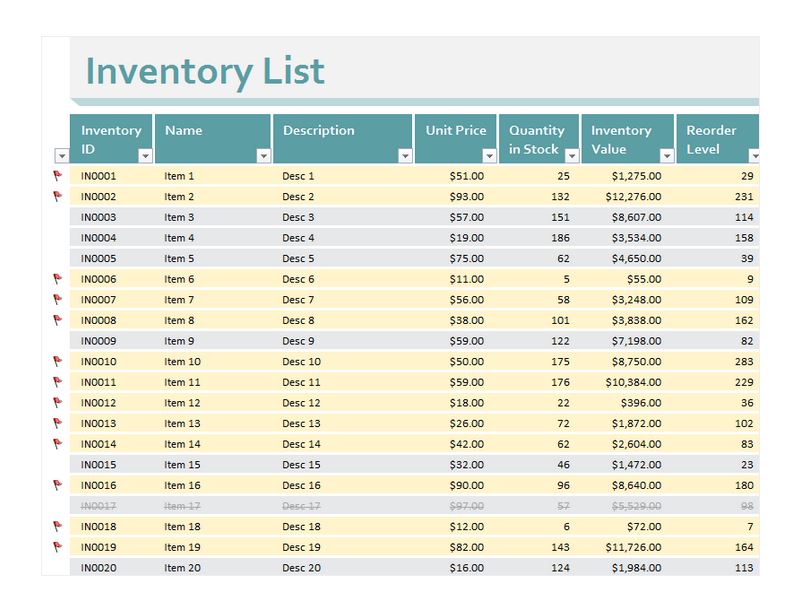5 Essential Tips for Creating an Excel Inventory Sheet

Effective inventory management is crucial for businesses of all sizes. Whether you're running a small retail store or managing a large warehouse, having a well-organized Excel inventory sheet can streamline your operations and save you time and money. Here are five essential tips for creating an Excel inventory sheet that will help keep your inventory in check:
1. Define Your Inventory Goals

Before diving into setting up your Excel inventory sheet, take a moment to define what you want to achieve:
- What data do you need to track? - Think about items, quantities, locations, and reorder points.
- Who will use the inventory sheet? - Are you designing it for warehouse staff or for your accounting department?
- What reports or analyses will you generate? - Consider the types of inventory reports you need to make business decisions.
By setting clear goals, you can design an inventory sheet that is more tailored to your specific needs.
2. Design with Clarity and Simplicity in Mind

When it comes to an Excel inventory sheet, clarity is king:
- Use clear and descriptive column headers like Item ID, Item Description, Quantity On Hand, Unit Price, Location, and Reorder Point.
- Make use of conditional formatting to highlight critical data, such as low stock levels.
- Organize your data with filters or sorting options to facilitate quick data retrieval.
- Set up freeze panes to keep headers in view while scrolling through data.
3. Implement Data Validation

Data accuracy is critical. Here’s how you can ensure your data is consistent:
- Data Validation Rules: Use Excel’s data validation feature to ensure only specific types or ranges of data are entered. For example, the quantity must be a number greater than zero.
- Dropdown Lists: Implement dropdown lists to streamline data entry and reduce errors, especially for categories or item names.
- Formula Validation: Use conditional formatting or error checking to spot when data doesn’t match your expected criteria.
4. Use Formulas for Efficiency

Excel’s calculation power can make inventory management much more efficient:
| Formula | Use |
|---|---|
| SUMIF/SUMIFS | To sum values based on specific conditions. Example: Calculate total inventory value where quantity > 0. |
| VLOOKUP | To look up and retrieve values from another table. Example: Pull product descriptions or prices. |
| IF/IFS | To perform conditional checks. Example: Alert when inventory levels are too low. |
| AVERAGEIF | To average values based on specific criteria. Example: Calculate the average sale price for items. |
These formulas can automate calculations, making updates to your inventory much quicker.
5. Maintain and Update Regularly

An inventory sheet is only useful if it reflects real-time data:
- Set a schedule for inventory updates - daily, weekly, or monthly based on your business needs.
- Consider using inventory management software that integrates with Excel for real-time updates.
- Regularly audit your inventory to ensure accuracy and update for discontinued items or new products.
🛠 Note: Always have a backup of your inventory sheet. Data loss can be detrimental, so consider using cloud storage or version control to safeguard your work.
Creating an Excel inventory sheet might seem daunting initially, but with these tips, you can design a tool that not only manages your inventory efficiently but also grows with your business. A well-structured inventory sheet allows for easy tracking, analysis, and decision-making, providing you with the insights you need to manage your stock effectively. Keep in mind, the real value of your inventory sheet comes from its accuracy, ease of use, and how well it serves your business's specific inventory management goals.
What are the benefits of using Excel for inventory management?

+
Excel offers flexibility in design, calculation capabilities, and accessibility. It allows you to customize your inventory sheet to your specific needs, perform complex calculations for forecasting and analysis, and it’s widely used, making it accessible for most employees.
How can I ensure my inventory data remains accurate?

+
Regular audits, data validation rules, and maintaining a consistent update schedule are key. Additionally, training staff on proper data entry and using dropdown lists to minimize errors can help ensure accuracy.
What types of formulas should I use in my inventory sheet?

+
Use formulas like SUMIF for totaling, VLOOKUP for data retrieval, IF/IFS for conditional checks, and AVERAGEIF for average calculations. These can automate updates and provide insights into your inventory levels and needs.
Can I use Excel in real-time inventory management?

+
Excel alone isn’t designed for real-time inventory management, but it can integrate with inventory management systems that do provide real-time updates. Consider these integrations to enhance your inventory control.
How often should I update my Excel inventory sheet?

+
The frequency of updates depends on your business model. Retail might require daily updates due to high turnover, while other businesses might find weekly or even monthly updates sufficient. Key is to find a balance that keeps your inventory data accurate without being overly labor-intensive.



